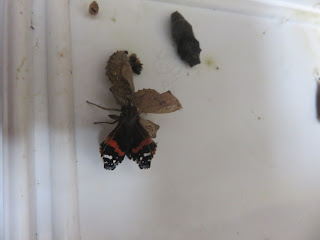Red Admirals need Nettles
Red Admiral Photo: Steve Andrews
The Red Admiral (Vanessa atalanta) is a very pretty butterfly you are probably familiar with. You can’t miss it with its striking red, black and white wings, and in the UK, it is one of the last butterflies to be seen in late autumn. We all love to see butterflies but many people don’t realise how important the plants the caterpillars need to feed on are. In the case of the Red Admiral, the main food-plants are Nettle species. The Stinging Nettle (Urtica dioica) is the most commonly used plant but here in Portugal where I live, the Annual Nettle (U. urens) is the species they use.
Annual Nettles Photo: Steve Andrews
These nettles spring up as a garden weed and on waste ground in the autumn and winter when rains fall. Sadly because they are regarded as a weed, many people destroy them, either manually with care, due to the stinging threat from the plant, or with herbicide, and any Red Admiral eggs, caterpillars or chrysalises, get destroyed too. I saw a large patch of Small Nettles growing on some rough ground in a shortcut between two roads in my neighbourhood. I checked for Red Admiral caterpillars and soon found some, which I took into care, just in case anyone came along and killed the plants. I am very glad I did because some council workers turned up and removed all the vegetation that was growing there. There is a skill to finding Red Admiral caterpillars, but it is very easy to learn. The caterpillars are usually found towards the top of a nettle stem and they fold leaves around themselves as shelters. The leaves are held with a small amount of caterpillar silk. They eat surrounding leaves and you can spot the holes in these leaves and their ragged appearance where they have been eaten away. Sometimes the Red Admiral caterpillar will pupate inside their shelters too, but not always, because they will also transform into chrysalises that hang suspended from nettle stalks or possibly on a wall, fence or other object near where the caterpillar has been feeding. I keep the caterpillars in sandwich boxes with a paper towel on the bottom to help absorb any dampness and to make it easier when cleaning out the container and providing new food. Often I find that the caterpillars will choose to pupate after spinning a pad of silk on the plastic top of the sandwich box. The chrysalises are brown but some are speckled with gold. As the butterfly inside becomes more developed and nears the time for emergence it becomes much darker and you can see the wings colouring up in the wing-case on each side of the chrysalis.
When the Red Admirals finally emerge, or eclose, as lepidopterists would say, they need to dry their wings thoroughly before they take their first flight. It is very important at this stage that they are not disturbed and that they don’t fall off whatever they are clinging to. This can be a problem for all species of butterflies at this stage of their life-cycles. Fallen butterflies can become cripples if they fail to expand and dry their wings properly. Usually all goes well, though, and the Red Admiral is all set to fly away. This butterfly can fly a long way. Many of those seen in the UK are migrants, though this species can hibernate in Britain too. In Portugal they have more than one generation but need nettles. I usually see them in autumn, winter and spring. In summer it is too hot and dry. There is a place in some woodland near where I live that I can almost guarantee I will be able to find a male Red Admiral every year in the right seasons. Of course, it isn’t the same butterfly but is obviously an ideal spot for a male of this species to create a territory he can patrol.
All photos by Steve Andrews







No comments:
Post a Comment